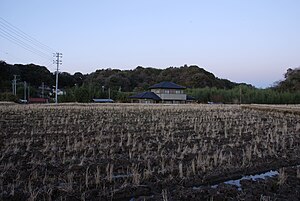Sanuki Domain

Sanuki Domain (佐貫藩, Sanuki-han) was a Japanese domain of the Edo period, located in Kazusa Province (modern-day Chiba Prefecture), Japan. It was centered on Sanuki Castle in what is now the city of Futtsu, Chiba.
History
The original Sanuki Castle was built by the Satomi clan, rulers of most of the Bōsō Peninsula during the Sengoku period. Following the Battle of Odawara in 1590, the Kantō region by was assigned to Tokugawa Ieyasu by the warlord Toyotomi Hideyoshi, who also restricted the Satomi to Awa Province for their lukewarm support of his campaigns against the Late Hōjō clan. Tokugawa Ieyasu appointed Naito Ienaga, one of his hereditary retainers, to be daimyō of the new 20,000 koku Sanuki Domain.
During the Siege of Fushimi in 1600 prior to the Battle of Sekigahara, Naito Ienaga was one of the last defenders of Fushimi Castle to fall to the forces of Ishida Mitsunari. He was succeeded by his son, Naito Masanaga, who was awarded an additional 10,000 koku for his efforts at the Siege of Osaka. He gained another 10,000 koku for his participation in the suppression of the Satomi clan at Tateyama Domain in Awa Province, and yet another 5,000 koku when Shogun Tokugawa Hidetada visited on an extended falconry expedition, thus bringing his total revenues to 45,000 koku. He was subsequently transferred to Iwakidaira Domain in Mutsu Province.
His replacement, Matsudaira Tadashige, was a 8,000 koku hatamoto of Fukuya Domain in Musashi Province, who was elevated to the ranks of the daimyō with an additional 7,000 koku stipend. He was subsequently transferred to Tanaka Domain in Suruga Province and Samuki Domain reverted to tenryō territory directly under the control of the Tokugawa shogunate.
In January 1639, Sanuki Domain was revived for Matsudaira Katsutaka, a former jisha-bugyō, whose holding had reached 15,000 koku, qualifying him as a daimyō. However, the Matsudaira clan were dispossessed from Sanuki under the tenure of his son, Matsudaira Shigeharu, for mismanagement, and Sanuki Domain again lapsed to tenryō status.
In May 1710, the domain was reestablished as a 16,000 koku holding for Abe Masatane, formerly daimyo of Kariya Domain in Mikawa Province. The Abe clan continued to rule Sanuki until the Meiji Restoration. The final daimyo of Sanuki Domain, Abe Masatsune, initially served with the pro-Tokugawa forces in the Boshin War against the strong advice of his senior retainers and refused to surrender his armory to the new Meiji government. He was subsequently imprisoned for a time, but was pardoned, and was appointed domain governor under the new administration, until the abolition of the han system in July 1871 and subsequently became a viscount under the kazoku peerage. Sanuki Domain became “Sanuki Prefecture”, which merged with the short lived “Kisarazu Prefecture” in November 1871, which later became part of Chiba Prefecture.
List of daimyō
 Naito clan (fudai) 1590-1622
Naito clan (fudai) 1590-1622
| # | Name | Tenure | Courtesy title | Court Rank | revenues |
|---|---|---|---|---|---|
| 1 | Naito Ienaga (内藤家長) | 1590–1600 | -none- | -none- | 20,000 koku |
| 2 | Naito Masanaga (内藤政長) | 1600–1622 | Sama-no-suke | Lower 4th (従四位下) | 45,000 koku |
 Matsudaira (Sakurai) clan (fudai) 1622-1633
Matsudaira (Sakurai) clan (fudai) 1622-1633
| # | Name | Tenure | Courtesy title | Court Rank | revenues |
|---|---|---|---|---|---|
| 1 | Matsudaira Tadashige (松平忠重) | 1622–1633 | Daizen-no-suke | Lower 5th (従五位下) | 15,000 koku |
 Matsudaira clan (fudai) 1638-1684
Matsudaira clan (fudai) 1638-1684
| # | Name | Tenure | Courtesy title | Court Rank | revenues |
|---|---|---|---|---|---|
| 1 | Matsudaira Katsutaka (松平勝隆) | 1638–1662 | Izumo-no-kami | Lower 5th (従五位下) | 15,000 koku |
| 2 | Matsudaira Shigeharu (松平重治) | 1662–1684 | Yamashiro-no-kami | Lower 5th (従五位下) | 15,000 koku |
 Abe clan (fudai) 1684-1871
Abe clan (fudai) 1684-1871
| # | Name | Tenure | Courtesy title | Court Rank | revenues |
|---|---|---|---|---|---|
| 1 | Abe Masatane (阿部正鎮) | 1710–1751 | Inaba-no-kami | Lower 5th (従五位下) | 16,000 koku |
| 2 | Abe Masaoki (阿部正興) | 1751–1764 | Inaba-no-kami | Lower 5th (従五位下) | 16,000 koku |
| 3 | Abe Masayoshi (阿部正賀) | 1764–1780 | Suruga-no-kami | Lower 5th (従五位下) | 16,000 koku |
| 4 | Abe Masazane (阿部正実) | 1780–1792 | Hyōbū-Shoyū | Lower 5th (従五位下) | 16,000 koku |
| 5 | Abe Masahiro (阿部正簡) | 1792–1825 | Suruga-no-kami | Lower 5th (従五位下) | 16,000 koku |
| 6 | Abe Masaakira (阿部正暠) | 1638–1652 | Yamashiro-no-kami | Lower 5th (従五位下) | 16,000 koku |
| 7 | Abe Masachika (阿部正身) | 1825–1836 | Suruga-no-kami | Lower 5th (従五位下) | 16,000 koku |
| 8 | Abe Masatsune (阿部正恒) | 1836–1871 | Suruga-no-kami | Lower 5th (従五位下) | 16,000 koku |
References
- Papinot, E (1910). Historical and Geographic Dictionary of Japan. Tuttle (reprint) 1972.
Bolitho, Harold. (1974). Treasures Among Men: The Fudai Daimyo in Tokugawa Japan. New Haven: Yale University Press. 10-ISBN 0-300-01655-7/13-ISBN 978-0-300-01655-0; OCLC 185685588
- Nussbaum, Louis Frédéric and Käthe Roth. (2005). Japan Encyclopedia. Cambridge: Harvard University Press. 10-ISBN 0-674-01753-6; 13-ISBN 978-0-674-01753-5; OCLC 48943301
- Template:Ja icon Sanuki on "Edo 300 HTML"
Further reading
- Kodama Kōta 児玉幸多 , Kitajima Masamoto 北島正元 (1966). Kantō no shohan 関東の諸藩. Tokyo: Shin Jinbutsu Ōraisha.
